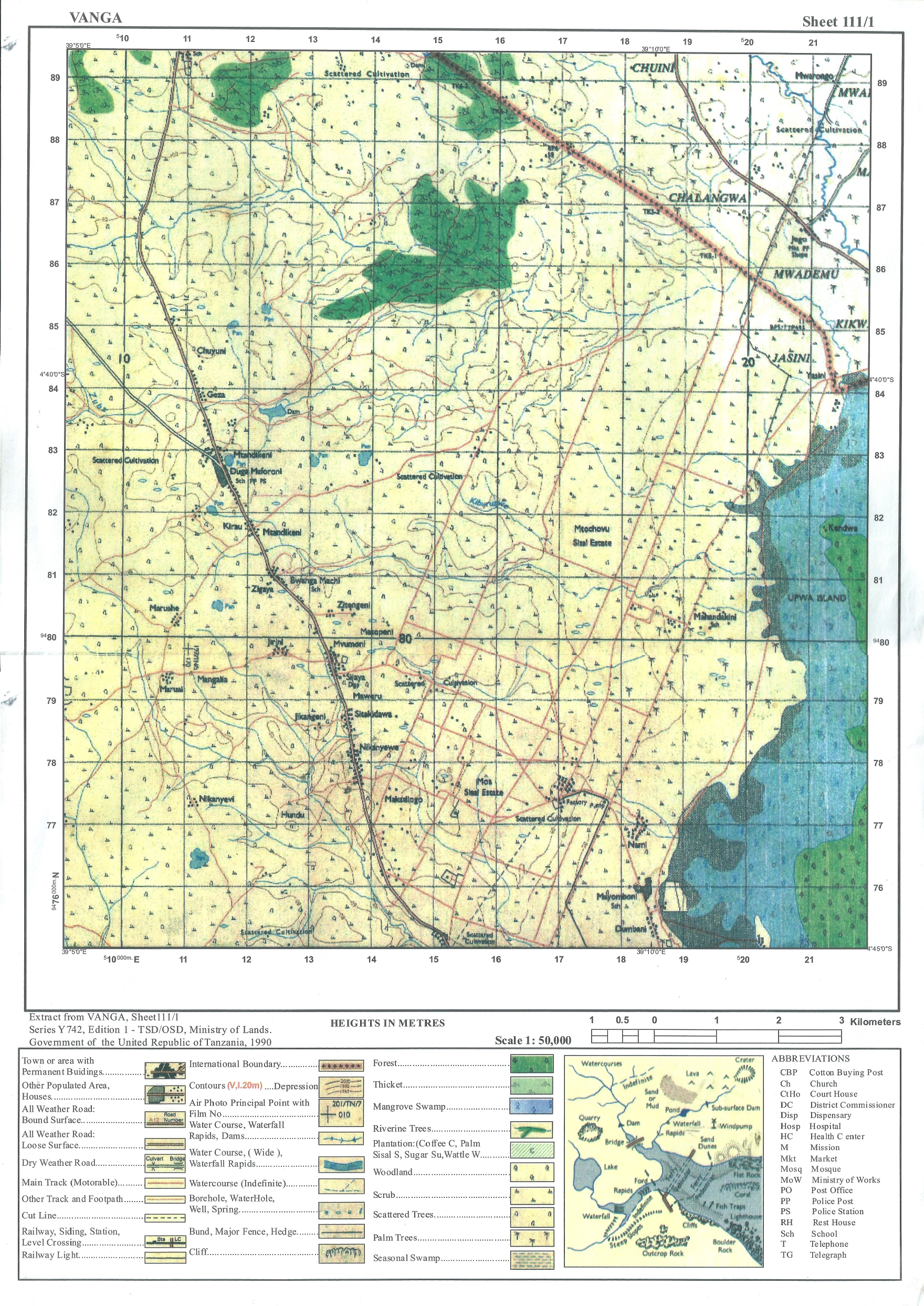THE UNITED REPUBLIC OF TANZANIA NATIONAL EXAMINATIONS COUNCIL ADVANCED CERTIFICATE OF SECONDARY EDUCATION EXAMINATION
113/1 Geography 1
(For Both School and Private Candidates)
Time: 3 Hours Wednesday, 03rdMay 2017 a.m.
Instructions
1. This paper consists of nine (9) questions in sections A and B.
2. Answer a total of five (5) questions; two (2) questions from section A and three (3) questions from section B. Question number one (1) is compulsory.
3. In section A, question number one (1) carries 25 marks and the rest 15 marks, while in section B each question carries 20 marks.
4. Credit will be given for the use of relevant sketch maps and diagrams.
5. Map extract of Vanga (sheet 111/1) is provided.
6. Non programmable calculators may be used.
7. Cellular phones are not allowed in the examination room.
8. Write your Examination Number on every page of your answer booklet(s).
SECTION A (40 marks)
Answer question number 1 and any other question from this section.
1. Study carefully the map extract of Vanga (sheet 111/1) provided and answer the following questions:
(a) Calculate the area covered by mangrove swamp at Upwa Island.
(b) Describe the nature of transport and communication system of the mapped area.
(c) Comment on the population distribution of the area and briefly explain three factors that have influenced population distribution at Vanga area.
(d) Comment on the nature of vegetation found at the area. Is there any relationship between climatic conditions found in the area with vegetation cover?
(e) With support of examples, identify the economic activities carried out in the mapped area.
(f) With vivid examples, determine the functions of Vanga sub-urban.
(g) Describe four factors that have affected the composition of the mapped area.
View Ans
2. Study carefully the data in the following table which shows the quantity (in thousands tones) of pyrethrum produced in Kenya from 1980 to 1989 and then answer the questions that follow:
| Year | 1980 | 1981 | 1982 | 1983 | 1984 | 1985 | 1986 | 1987 | 1988 | 1989 |
| Tones (000) | 114 | 162 | 240 | 258 | 87 | 34 | 74 | 93 | 102 | 124 |
(a) Present the data using divergent line graph.
(b) Comment on the trend of production.
(c) Give two merits and demerits of the divergent line graph.
View Ans
3. During a Compass Survey an amateur Surveyor recorded 070° as forward bearings from point X to Y and 254° as back bearing.
(a) Correct the discrepancy of these readings.
(b) Identify four sources of errors during the Comass Survey.
View Ans
4. (a) Calculate the photo distance provided that the map distance is 3 inches, map scale is 1:25,000 and photo scale is 1:18,750.
(b) Differentiate the following terms:
(i) Principal point and focal length.
(ii) Flying height and flight line.
(iii) Datum and mosaic.
View Ans
SECTION B (60 marks)
Answer three (3) questions from this section.
5. “Wetlands are not Wastelands”. Discuss by giving eight points.
View Ans
6. With the aid of the diagrams, explain any five types of depressions in which lakes are formed.
View Ans
7. Discuss eight factors that influence the variation in the amount of insolation received on the earth surface.
View Ans
8. Discuss six theories which account for climatic change.
View Ans
9. With vivid examples,
(a) describe three stages in the formation of a delta.
(b) explain three conditions necessary for the formation of the delta.

View Ans
THE UNITED REPUBLIC OF TANZANIA NATIONAL EXAMINATIONS COUNCIL
ADVANCED CERTIFICATE OF SECONDARY EDUCATION EXAMINATION
113/2 GEOGRAPHY 2
HUMAN AND WORLD ECONOMIC GEOGRAPHY
(For Both School and Private Candidates)
Time: 3 Hours Friday, 05thMay 2017 p.m.
Instructions
1. This paper consists of eight (8) questions sections A and B.
2. Answer a total of five (5) questions, choosing two (2) questions from section A and three (3) question from section B.
3. Each question carries twenty (20) marks.
4. Cellular phones are not allowed in the examination room.
5. Write your Examination Number on every page of your answer booklet(s).
SECTION A (40 marks)
POPULATION AND DEVELOPMENT
Answer two (2) questions from this section.
1. Analyse eight population problems of underdeveloped countries.
View Ans
2. Giving six reasons, explain why population growth in Tanzania is a natural outcome of women’s lack of economic and social opportunities.
View Ans
3. Examine four achievements and four constraints of population policy in Tanzania.
View Ans
SECTION B (40 marks)
REGIONAL FOCAL STUDIES
4. Assess six challenges facing Tanzanian peasants in practicing organic farming.
View Ans
5. Examine eight factors for the successful beef farming in the USA.
View Ans
6. “Fossil fuels are both energy resources for economic development and instruments of environmental destruction”. Justify the statement with eight points.
View Ans
7. With concrete examples, analyse eight factors which influence the location of an industry.
View Ans
8. Analyse four advantages and four disadvantages of railway transport.
View Ans
 For Call,Sms&WhatsApp: 255769929722 / 255754805256
For Call,Sms&WhatsApp: 255769929722 / 255754805256
 For Call,Sms&WhatsApp: 255769929722 / 255754805256
For Call,Sms&WhatsApp: 255769929722 / 255754805256
 For Call,Sms&WhatsApp: 255769929722 / 255754805256
For Call,Sms&WhatsApp: 255769929722 / 255754805256